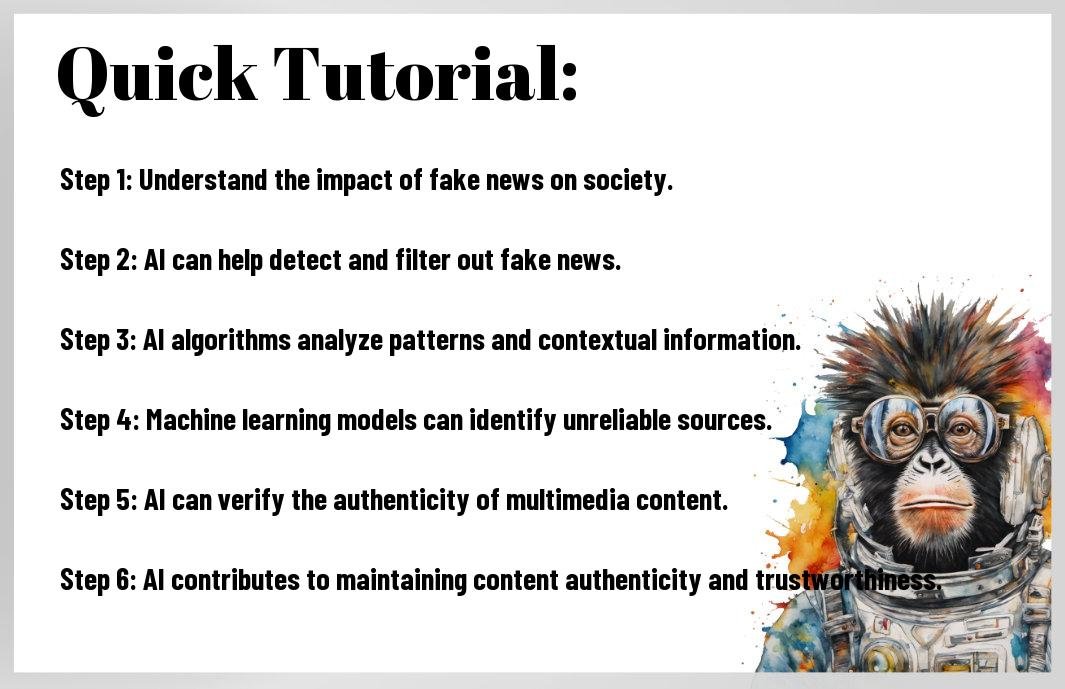Delving into the realm of artificial intelligence (AI) and its pivotal role in the battle against fake news and the preservation of content authenticity is crucial in today’s digital age. As we navigate the vast landscape of information online, the need for reliable and trustworthy sources becomes increasingly paramount. In this top 10 listicle, we will explore the various ways in which AI is being utilized to combat the proliferation of fake news and uphold the authenticity of online content. From detecting misinformation to verifying the credibility of sources, AI is revolutionizing the fight against deceptive practices in the digital sphere.
Key Takeaways:
- AI can help detect and combat fake news: Artificial intelligence can be used to analyze content and detect patterns that indicate the likelihood of fake news, helping to combat its spread.
- Content authenticity can be verified with AI: AI technology can be used to verify the authenticity of content, such as images and videos, helping to prevent the spread of misleading or manipulated information.
- Natural language processing is crucial in identifying fake news: AI-powered natural language processing can help identify misleading or false information by analyzing language patterns and sources of information.
- AI can assist in fact-checking and verification: By using AI algorithms, fact-checking processes can be expedited and improved, helping to identify accurate information and combat misinformation.
- Regulatory guidelines and ethical considerations are essential in AI implementation: While AI can be a powerful tool in combating fake news, it is crucial to establish regulatory guidelines and ethical considerations to ensure its responsible and ethical use in maintaining content authenticity.

Detecting Fake News
The rise of fake news in the digital age has created a pressing need for advanced technologies to detect and combat its spread. A key player in this arena is artificial intelligence, which offers sophisticated tools and techniques to identify and filter out misinformation and disinformation from the vast sea of digital content.
Pattern recognition
News articles and content containing fake information often follow certain patterns and characteristics that can be identified through advanced machine learning and natural language processing algorithms. By analyzing the language, structure, and source of the content, AI can effectively flag potential instances of fake news and provide a basis for further investigation.
AI-powered pattern recognition can also be utilized to track the propagation of fake news across various platforms and networks, enabling a proactive approach to mitigating its influence and preventing its viral spread.
Fact-checking algorithms
For an even deeper level of scrutiny, AI-driven fact-checking algorithms can be deployed to verify the accuracy and credibility of news content. These algorithms can cross-reference information with reputable sources, detect inconsistencies, and assess the overall reliability of the content. This level of fact-checking goes beyond simple pattern recognition, providing a more thorough and comprehensive validation process.
Fact-checking algorithms leverage advanced AI techniques such as natural language understanding and knowledge graph analysis to ensure that the information presented is accurate and trustworthy, thereby aiding in the maintenance of content authenticity and combatting the dissemination of fake news.
Content Authentication
Assuming you are interested in the impact of AI on content authenticity, you can explore the Impact of AI on Content Authenticity to gain deeper insights into this vital topic.
Digital Watermarking
Content authentication is crucial in combating fake news and ensuring the authenticity of digital content. One method that leverages AI technology for content authentication is digital watermarking. Digital watermarking involves embedding information into the content itself, making it possible to verify the original source and integrity of the content. With AI, digital watermarking techniques have advanced to accurately embed and extract these watermarks, providing a reliable way to authenticate digital content.
Moreover, AI-powered digital watermarking offers a robust solution for maintaining the authenticity of images, videos, and other multimedia content, thereby mitigating the spread of fake or misleading information across various platforms.
Blockchain Verification
On the other hand, blockchain verification plays a pivotal role in content authentication. The decentralized and immutable nature of blockchain technology ensures that once content is verified and recorded on the blockchain, it cannot be altered or tampered with. This provides a trustworthy mechanism for verifying the authenticity of digital content, especially in the era of rampant misinformation and fake news. The integration of AI in blockchain verification further enhances the efficiency and accuracy of authenticating content, establishing a secure and transparent framework for content validation.
The synergy between AI and blockchain verification holds the potential to significantly impact the fight against fake news and the preservation of content authenticity, thereby contributing to a more trustworthy and reliable digital environment.
Social Media Monitoring
Now, social media monitoring is a crucial aspect of combating fake news and maintaining content authenticity. By leveraging AI technologies, organizations can scan through the large volumes of social media content to identify and address misinformation. This involves monitoring not only traditional news sources, but also social media platforms where fake news tends to spread rapidly. To learn more about the role of AI in combating fake news, you can read our article on How AI Can Tackle Fake News and Bias to Create Authentic Experiences.
Anomaly detection
Anomaly detection is a key component of social media monitoring to combat fake news. AI algorithms can be trained to detect abnormal patterns or outliers in social media content, such as sudden surges in the spread of certain articles or the use of specific misleading keywords. By identifying these anomalies, organizations can quickly investigate and address potentially fake news before it spreads further.
Finding abnormal patterns in social media content allows for timely intervention and helps in maintaining the authenticity of the information being circulated. These anomalies can be identified through advanced machine learning techniques and natural language processing, making the process more effective and efficient in combating fake news and maintaining content authenticity.
Trend analysis
Trend analysis plays a crucial role in social media monitoring to combat the spread of fake news. AI-powered tools can analyze social media trends and identify patterns that indicate potential misinformation. By detecting sudden spikes in the sharing of certain articles or the propagation of misleading narratives, organizations can take proactive measures to address the issue and prevent the further spread of fake news. This proactive trend analysis is vital in maintaining content authenticity and combating the spread of misinformation on social media platforms.

Public Awareness
Keep up to date with the latest research and trends in combatting fake news with this insightful article on fake news research trends and linkages to generative artificial intelligence. Understanding the evolving landscape of fake news and the role of AI is essential for anyone concerned with maintaining content authenticity in today’s digital world.
Educational bots
Awareness about fake news and content authenticity can be enhanced through the use of educational bots. These AI-powered tools can engage with users, providing them with information on how to identify and combat fake news. By simulating conversations and interactions, educational bots can effectively deliver key messages about the importance of content verification and critical thinking.
Real-time alerts
One of the ways AI combats fake news and maintains content authenticity is through real-time alerts. AI algorithms can continuously monitor and analyze online content, detecting patterns and signals that indicate the presence of fake news. When identified, these algorithms can trigger real-time alerts, notifying users and platforms about potentially misleading or false information. By providing immediate warnings, AI helps prevent the spread of fake news and mitigates its impact.
For instance, AI algorithms can be programmed to scan social media posts, news articles, and other digital content for keywords, images, or phrases commonly associated with fake news. When a match is found, the algorithm can generate a real-time alert, prompting further investigation and evaluation of the content’s authenticity.
Summing up
With these considerations, it is clear that AI plays a crucial role in combating the spread of fake news and maintaining content authenticity. Its ability to efficiently analyze vast amounts of data and detect patterns of misinformation is essential in the fight against the dissemination of false information. AI tools also aid in identifying and flagging potentially misleading content, empowering platforms and users with the means to make informed decisions about the information they encounter. As technology continues to advance, AI will undoubtedly continue to play a fundamental role in ensuring the authenticity and reliability of online content.
FAQ
Q: What is the role of AI in combating fake news and maintaining content authenticity?
A: AI plays a crucial role in identifying and flagging fake news and unreliable content by analyzing patterns, sources, and credibility indicators.
Q: How does AI detect fake news and maintain content authenticity?
A: AI algorithms use natural language processing, sentiment analysis, and machine learning to analyze the language, source, and context of the content to determine its authenticity.
Q: Can AI prevent the spread of misinformation and fake news?
A: AI can help in preventing the spread of misinformation by identifying and flagging potentially false or misleading content before it goes viral.
Q: What are the limitations of AI in combating fake news?
A: AI algorithms may have limitations in understanding sarcasm, satire, or subtle nuances in language, which can lead to misinterpretation of content.
Q: How can AI be used to support content authenticity and combat fake news in the future?
A: AI can be further developed to collaborate with human fact-checkers, enhance media literacy, and improve the overall credibility and trustworthiness of online content.


